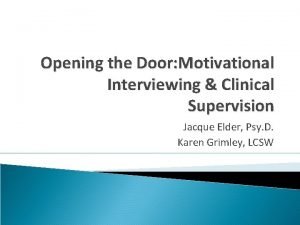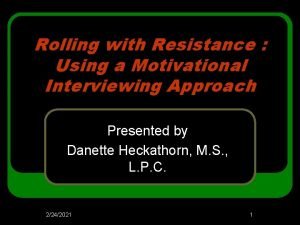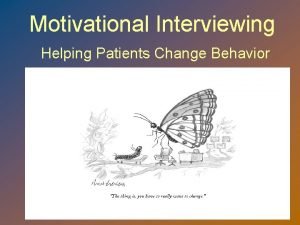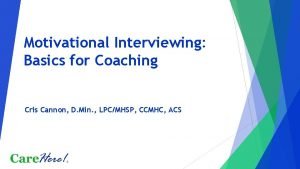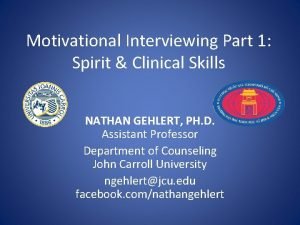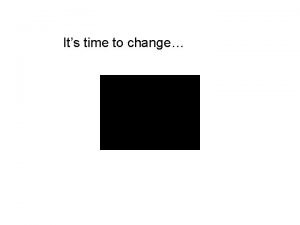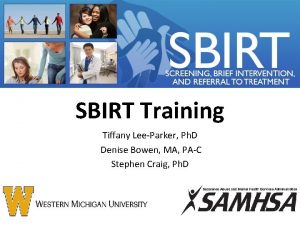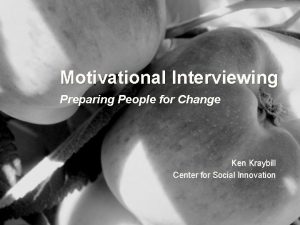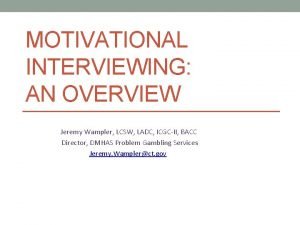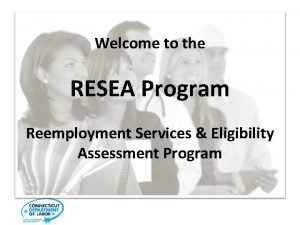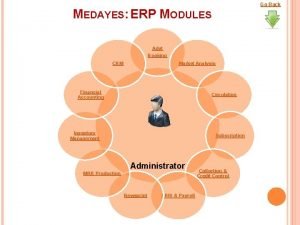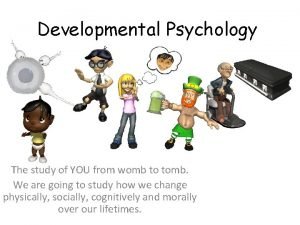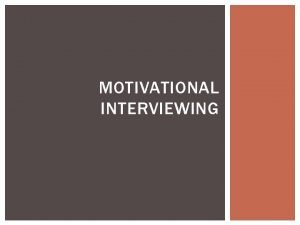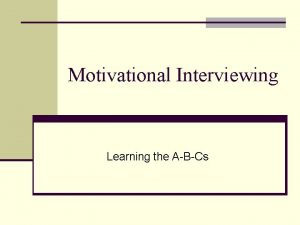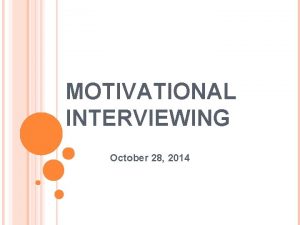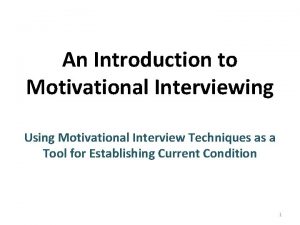HiTouch Healthcare MOTIVATIONAL INTERVIEWING MI WHAT TO EXPECT


































- Slides: 34

Hi-Touch Healthcare

MOTIVATIONAL INTERVIEWING (MI)

WHAT TO EXPECT IN THIS PRESENTATION Definition of Motivational Interviewing About this Training The Stages of Change Ambivalence Activity The Spirit of MI Persuasion Activity Guiding Principles Tape-Face Listening Activity Reflective Listening OARS Affirmation Activity

DEFINITION OF MI William Miller & Stephen Rollnick: It is “a collaborative, goal-oriented style of communication with particular attention to the language of change. It is designed to strengthen personal motivation for and commitment to a specific goal by eliciting and exploring the person’s own reasons for change within an atmosphere of acceptance and compassion. ” (cited in About Motivational Interviewing, n. d. ).


ABOUT THIS TRAINING “Learning a complex skill like MI is a process that necessarily happens over time. You can’t push skill” (MINT, 2014, p. 4).

MOTIVATIONAL INTERVIEWING SIMPLIFIED Process simplicity FOUR STEPS: – – Engage Focus Evoke Plan (HIS. gov, n. d) Human complexity

CHANGE IS COMPLEX

8 STAGES OF MI TRAINING The spirit of MI Use OARS • Open-ended questions, Affirmations, Reflective thinking/listening and Summarizing Recognize and reinforce change talk Eliciting and strengthening change talk Rolling with resistance Developing a change plan Consolidating commitment Switching to other styles (Miller & Moyes, 2007)

LAYPERSON’S DEFINITION “A collaborative conversation to strengthen a person’s own motivation for commitment to change. ” (Umass, n. d. ).

AMBIVALENCE ACTIVITY

SPIRIT OF MI Collaborative vs. Confrontational Evocative vs. Imposing Autonomy vs. Authority

COLLABORATIVE Partnership from the viewpoint of the patient. • Not a confrontation of patient/client health behaviors from the viewpoint of the “expert. ” Rapport and trust are built via interpersonal relationship development. • Not a reliance on a style of hierarchical, power, and dominance. “Although they may see things differently, therapeutic process is focused on mutual understanding, not therapist being right. ” (Umass, n. d. )

EVOCATIVE Bring out the patient’s thoughts and ideas. • Not practitioner opinions as motivation. Lasting change comes from personal determination to change. “Often health care seems to involve giving patients what they lack, be it medication, knowledge, insight, or skills. ” (Miller, Rollnick, Butler, 2008).

AUTONOMY The real power to change belongs to the patient, not the “authority. ” Empower patients through personal responsibility. • Patients must follow through to achieve change. There is no one “right way. ” • Patients are encouraged to develop a list of options for how to make change.

BASICS TO KNOW DEARS Develop Discrepancy: • Evoke patient’s own reason for and against change Express Empathy: • Show warmth and caring; support the patient’s self-esteem Amplify Ambivalence: • Help patient acknowledge and explore both sides Roll with Resistance: • It’s expected; work with it not against it Support Self Efficacy: • Question and reflect to help the patient believe s/he can change (Smartrecovery. org, n. d)

“There is something in human nature that resists being coerced and told what to do. Ironically, it is acknowledging the other’s right and freedom not to change that sometimes makes change possible. ” (Miller, Rollnick, Butler, 2008).

PERSUASION ACTIVITY ROLE-PLAY Partner up! Don’t share your role with your partner. Get into it! Share with each other when time is called. Large group share.

4 GUIDING PRINCIPLES Resist the “righting” reflex. Understand your patient’s motivation. Listen to your patient. Empower your patient.

THREE COMMUNICATION STYLES Directing Following Guiding Each style has valueh

3 COMMUNICATION SKILLS “Asking, listening, and informing are the communication equivalent of technical proficiency in music; the more proficient, the wider the range of application, skillfulness, and enjoyment. ” (Rollnick, Miller & Butler, 2008).

ASKING, INFORMING, & LISTENING VARY ACCORDING TO THE STYLE Asking • “How may times has that happened? ” ―[directing] • “What kind of change makes sense to you? ” ―[guiding] • “How have you been since your son died? ” ―[following]

ASKING, INFORMING, & LISTENING VARY ACCORDING TO THE STYLE Informing • “Yes, it’s a common experience; many patients also feel quite shocked and unsettled about simple things like going to the toilet. ” ―[following] • “Changing your diet would make sense medically, but how does that feel for you? ” ― [guiding] • “Your best option is to take these tablets. ” ―[directing]

ASKING, INFORMING, & LISTENING VARY ACCORDING TO THE STYLE Listening • “You’re feeling concerned about your weight, and you are not sure where to go from here. ” ―[guiding] • “So you understand what’s going to happen this morning, but you want me to tell you more about what will happen later on. ” ―[directing] • “This has been a huge shock. ” ―[following]

NOT LISTENING

TAPE-FACE LISTENING ACTIVITY • Partner up • One speaker & one listener • Speaker talks • Listeners is absolutely silent! • Got tape?

REFLECTIVE LISTENING Brings to life expressing empathy. • The patient feels the practitioner understands issues from his/her perspective. Used strategically to help move the patient through ambiguity and toward change. There are several levels ranging from simple to complex reflective listening. • Initial engagement • Transition between stages • Conclude sessions

THOMAS GORDON’S MODEL OF LISTENING Words the speaker says Words the listener hears What the speaker means What the listener thinks the speaker means

REFLECTIVE LISTENING ACTIVITY One thing that I like about myself is… “The single biggest problem in communication is the illusion that it has taken place. ” -George Bernard Shaw

OARS: A SKILL SET Open-ended questions • Can’t be answered yes or no Affirmations • Recognize patient’s strengths • Help reframe behavior and build rapport Reflections • Reflective thinking/ listening (The previous activity demonstrated one depth of this) Summaries • Special types of reflection that help move the patient along. • May include recap, or demonstrate understanding and interest, or highlight both sides of ambiguity.

AFFIRMATION ACTIVITY

EXAMPLE Example: Characteristic Strength Affirmation Cheerful Optimistic “No matter what hardships you face, you keep a sunny outlook. ”

EXAMPLE Characteristic Demanding Strength Resourceful Affirmation “You are very good at getting the resources that you need. ”

THANK YOU! Questions? Comments?
 Darn cat change talk
Darn cat change talk Motivational interviewing stages of change
Motivational interviewing stages of change Motivational interviewing
Motivational interviewing How to roll with resistance
How to roll with resistance Dares motivational interviewing
Dares motivational interviewing Krishna guadalupe
Krishna guadalupe Double sided reflection example
Double sided reflection example Agreement with a twist motivational interviewing
Agreement with a twist motivational interviewing Cris cannon
Cris cannon Motivational interviewing case management
Motivational interviewing case management Darn cat motivational interviewing
Darn cat motivational interviewing Contoh motivational interviewing
Contoh motivational interviewing Stages of change social work
Stages of change social work Mi readiness ruler
Mi readiness ruler Reds motivational interviewing
Reds motivational interviewing Motivational interviewing dears
Motivational interviewing dears Motivational interviewing
Motivational interviewing Darn cat motivational interviewing
Darn cat motivational interviewing Dears motivational interviewing
Dears motivational interviewing Darn cat motivational interviewing
Darn cat motivational interviewing Motivational interviewing
Motivational interviewing Motivational interviewing ears
Motivational interviewing ears Darn cat motivational interviewing
Darn cat motivational interviewing Ken kraybill
Ken kraybill Jeremy wampler
Jeremy wampler Motivational interviewing schizophrenia
Motivational interviewing schizophrenia Motivational interviewing
Motivational interviewing Healthcare and the healthcare team chapter 2
Healthcare and the healthcare team chapter 2 Sports medicine meaning
Sports medicine meaning Introduction to hospitality 7th edition
Introduction to hospitality 7th edition Immersion plan sample
Immersion plan sample Reemployment
Reemployment Expect the unexpected
Expect the unexpected Capiche etymology
Capiche etymology Womb to tomb psychology
Womb to tomb psychology


